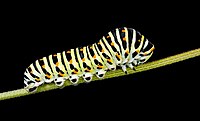
Photo from wikipedia
Simple Summary In the current review, we gathered and summarized the up-to-date information on the life cycle, distribution, outbreaks, control, and health issues to humans and animals of the European… Click to show full abstract
Simple Summary In the current review, we gathered and summarized the up-to-date information on the life cycle, distribution, outbreaks, control, and health issues to humans and animals of the European Spongy moth. Overall, this noxious species is easily expanded to new areas, causing serious large-scale damage rapidly. The management of this insect is difficult since the chemicals are harmful to human health and the environment, and natural enemies are not able to cause sufficient reduction of the populations of L. dispar. Finally, the potential use of biotechnological and physical methods against L. dispar is discussed. Abstract The European Spongy moth, Lymantria dispar (L.) (Lepidoptera: Erebidae), is an abundant species found in oak woods in Central and Southern Europe, the Near East, and North Africa and is an important economic pest. It is a voracious eater and can completely defoliate entire trees; repeated severe defoliation can add to other stresses, such as weather extremes or human activities. Lymantria dispar is most destructive in its larval stage (caterpillars), stripping away foliage from a broad variety of trees (>500 species). Caterpillar infestation is an underestimated problem; medical literature reports that established populations of caterpillars may cause health problems to people and animals. Inflammatory reactions may occur in most individuals after exposure to setae, independent of previous exposure. Currently, chemical and mechanical methods, natural predators, and silvicultural practices are included for the control of this species. Various insecticides have been used for its control, often through aerial sprayings, which negatively affect biodiversity, frequently fail, and are inappropriate for urban/recreational areas. However, bioinsecticides based on various microorganisms (e.g., entomopathogenic viruses, bacteria, and fungi) as well as technologies such as mating disruption using sex pheromone traps have replaced insecticides for the management of L. dispar.
Journal Title: Insects
Year Published: 2022
Link to full text (if available)
Share on Social Media: Sign Up to like & get
recommendations!